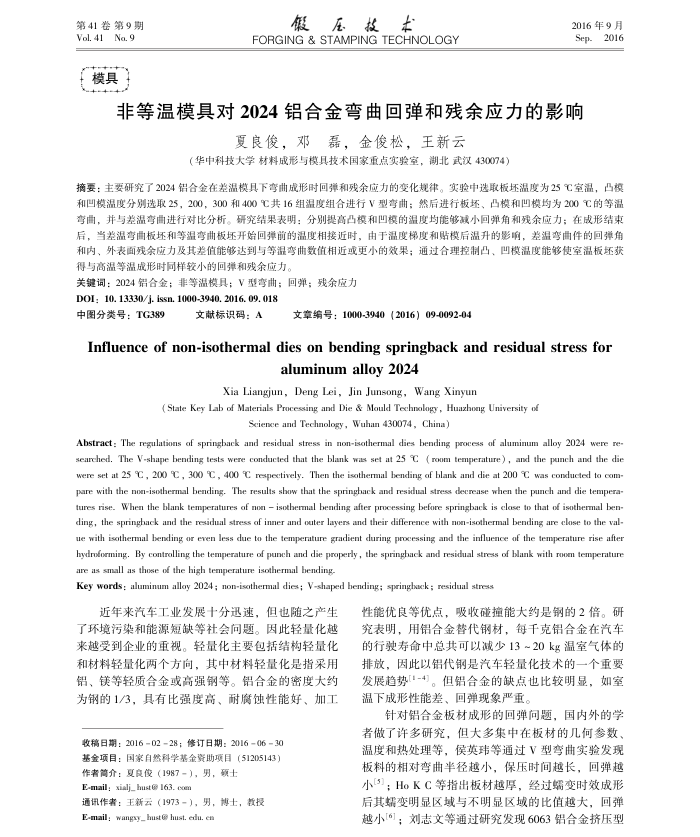非等温模具对2024铝合金弯曲回弹和残余应力的影响
内容简介
 第41卷第9期 Vol. 41No.9
第41卷第9期 Vol. 41No.9模具
叙压技木
FORGING & STAMPING TECHNOLOGY
2016年9月 Sep.2016
非等温模具对2024铝合金弯曲回弹和残余应力的影响
夏良俊,邓磊,金俊松,王新云
(华中科技大学材料成形与模具技术国家重点实验室,湖北武汉430074)
和回模温度分别选取25,200,300和400%共16组温度组合进行V型弯曲;然后进行板坏、凸模和凹模均为200℃的等温弯曲,并与差温弯曲进行对比分析。研究结果表明:分别提高凸模和凹模的温度均能够减小回弹角和残余应力;在成形结束后,当差温弯曲板坏和等温弯曲板坏开始回弹前的温度相接近时,由于温度梯度和贴模后温升的影响,差温弯曲件的回弹角和内、外表面残余应力及其差值能够达到与等温弯曲数值相近或更小的效果;通过合理控制凸、凹模温度能够使室温板坏获得与高温等温成形时同样较小的回弹和残余应力
关键词:2024铝合金;非等温模具;V型弯曲;回弹;残余应力 DOI: 10. 13330/j. issn. 1000-3940. 2016. 09, 018
中图分类号:TG389
文献标识码:A
文章编号:1000-3940(2016)09-0092-04
Influence of non-isothermal dies on bending springback and residual stress for
aluminum alloy2024
Xia Liangjun, Deng Lei, Jin Junsong, Wang Xinyun
( State Key Lab of Materials Processing and Die & Mould Technology , Huazhong University of
Science and Technology, Wuhan 430074, China)
Abstract: The regulations of springback and residual stress in non-isothermal dies bending process of aluminum alloy 2024 were re-searched. The V-shape bending tests were conducted that the blank was set at 25 °C ( room temperature) , and the punch and the die were set at 25 ℃ , 200 °℃ , 300 °C , 400 °C respectively.
Then the isothenmal bending of blank and die at 200 °C was conducted to com-
pare with the non-isothermal bending, The results show that the springhack and residual stress decrease when the punch and die tempera-
tures rise. When the blank temperatures of n
isothermal bending after processing before springback is close to that of isothermal ben-
ding, the springhack and the residual stress of inner and outer layers and their difference with non-isothermal bending are close to the val-ue with isothemal bending or even less due to the temperature gradient during processing and the influence of the temperature rise after anuaduray oor a qurri jo ssas enpasa pue prqiuads a adoad ap pue qaund o anesaduar a suroruoa ig -Buuogupi are as small as those of the high temperature isothermal bending-
Key words : aluminum alloy 2024 ; non-isothemal dies; V-shaped bending; springhack ; residual stress
近年来汽车工业发展十分迅速,但也随之产生了环境污染和能源短缺等社会问题。因此轻量化越来越受到企业的重视。轻量化主要包括结构轻量化和材料轻量化两个方向,其中材料轻量化是指采用
镁等轻质合金或高强钢等。铝合金的密度大约
留、
为钢的1/3,具有比强度高、耐腐蚀性能好、加工
收稿日期:20160228:修订日期:20160630 基金项目:国家自然科学基金资助项目(51205143)
作者简介:夏良俊(1987-),男,额士 E-mail: xialj_hust@ 163. com
通讯作者:王新云(1973-),男,博士,教授 E-mail: wangxy_hust@ hust. edu. en
性能优良等优点,吸收碰撞能大约是钢的2倍。研究表明,用铝合金替代钢材,每千克铝合金在汽车的行驶寿命中总共可以减少13~20kg温室气体的排放,因此以铝代钢是汽车轻量化技术的一个重要发展趋势[1-4)。但铝合金的缺点也比较明显,如室温下成形性能差、回弹现象严重
针对铝合金板材成形的回弹问题,国内外的学者做了许多研究,但大多集中在板材的几何参数温度和热处理等,侯英玮等通过V型弯曲实验发现板料的相对弯曲半径越小,保压时间越长,回弹超小[5]:HoKC等指出板材越厚,经过蝠变时效成形后其螺变明显区域与不明显区域的比值越大,回弹越小[6];刘志文等通过研究发现6063铝合金挤压型
上一章:大型机床床身热变形及其结构优化
下一章:地锚拉杆镶嵌锻造后再结晶的研究